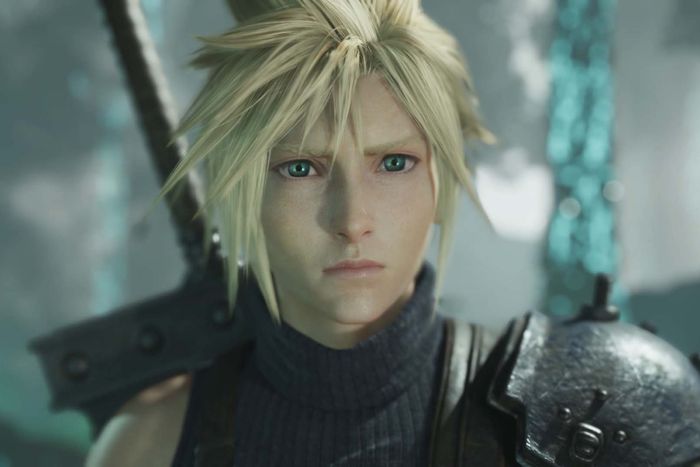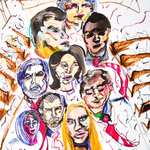
Some ten hours into Final Fantasy VII Rebirth, I came across a group of children playing beneath a towering military installation. Their playground was a patch of scrubland swathed in gas and it was causing them to act bizarrely. When they stepped into the miasma — poof! — they became frogs; when they stepped out, they transformed back into their human selves. Naturally, the children made their own fun out of these toxic circumstances, inviting the serious, spiky-haired protagonist, Cloud Strife, to join them for a game they christened “jumpfrog.”
This scene gets to the crux of what has changed, and what hasn’t, in Final Fantasy VII Rebirth, the second installment of a lavish three-part reimagining of the beloved 1997 classic. The first entry, 2020’s Final Fantasy VII Remake, was a propulsive and almost entirely linear romp through the cyberpunk city of Midgar, one that began with a thrilling act of eco-terrorist sabotage and scarcely let up in pace thereafter. Rebirth, on the other hand, is a gigantic open-world experience consisting of distinct zones connected by extravagant dungeons. This brings about a notable shift in accent — less of an emphasis on doing (although you still make things go kaboom) than simply bearing witness to how people are living. The game’s purview extends to the downtrodden toiling (and playing, like those youngsters) under the neo-feudal yoke of Shinra, the energy company that doubles as an autocratic city-state. It also casts a steely gaze on the privileged few basking in riches elsewhere. Like our own world currently going through it, Rebirth brims with injustice, the full extent of which unfurls slowly through its ravaged setting.
But the story opens at breakneck speed, picking up straight after the events of Remake. Large portions of Midgar have been reduced to rubble and the nefarious Sephiroth has escaped. So the motley crew of Cloud, Aerith, Tifa, Barrett, and a mohawk-rocking, talking dog called Red XIII embark on the kind of open-world adventure that fans of the series have long clamored for. I’d wager Rebirth lives up to their lofty expectations.
The sequel to Remake presents a more traditional open world than Square Enix’s previous attempt at the genre, 2015’s Final Fantasy XV (criticized by many for its perceived “emptiness”). This is sprawling, (mostly) beautiful, and filled with all manner of things to do. It follows the rhythm of Ubisoft titles like Assassin’s Creed: Climb some kind of mast/radar to scan the local area, which then reveals a plethora of tasks. It is also janky and cumbersome to explore on foot, which is why you’ll want to spend most of your time on the back of the feathered chocobos, whose jerky bird-like movements distract less than Cloud Strife juddering across the landscape. What Rebirth doesn’t offer is an emergent, physics-driven open world in the vein of recent Zelda games. Rather its mechanics, combat, exploration, and other little interactions are tidily siloed off from one another. It might depict a realm of wondrous nature and a menagerie of wild creatures, but Rebirth is never unruly; as such, it never quite hits the heights of the genre’s most expressive works.
That’s not to say there isn’t majesty in this open world. The quality just resides less in how it plays than how it furthers what is perhaps the most enduring aspect of FF7 — its unflinching (and none-too-subtle) ecological allegory. Miles of Shinra pipelines snake across the landscape, funneling “mako” (the game’s life-force equivalent of crude oil) to the wider reaches of the polity. At one stage, about to embark on a mountain climb, Barrett tells the party not to get too excited about what they might see from the top. “The view ain’t all that,” he says. “Not unless you enjoy staring at ruined reactors.” But poke about the undulating hills and massive cliff formations and you’ll come across small-scale settlements whose residents are getting by in whatever way they can. The hippies of Crow’s Nest, for example, lacking the activist bent of Cloud and his conspirators, spend their days smoking shisha while listening to laid-back country rock.
The message rings through loud and clear: In times of crisis, even the most resilient of us need to blow off some steam. This includes Cloud, Aerith, Tifa, Barrett, and Red XIII, who partake in an all-new set of mini-games including a chaotic take on soccer; the aforementioned “jumpfrog”; a card game called Queen’s Blood; and a surprisingly in-depth (and difficult) piano simulation. None are pinnacles of game design (certainly no match for the first-class combat, which remains utterly thrilling), but they illustrate how the Tokyo-based studio conceives of the series — as a “toy box,” according to series producer Yoshinori Kitase.
“Toybox” implies a kind of childlike joy — surprise, delight — which is certainly found in the moments where you track wildlife to find twinkling “lifesprings.” But Rebirth also has a sometimes painful adolescent streak, particularly in its handling of Cloud’s love interests, Tifa and Aerith, who are often presented as little more than objects of titillation. (One beach scene verges on soft porn). It is also camp, sometimes tedious (a segue fetch quest is pure filler), and yet ultimately lands upon an enthralling harmony of character, story, and setting infused with light-touch silliness and emotional intensity. Such is the open-world design, it often feels like you’re directing action figures about a gorgeous, expensively produced play set — but what a play set this is. And when the movie-quality cinematics kick in, these action figures come alive.
If Remake delivered the version of Midgar that existed in the imaginations of fans, then Rebirth does the same for FF7’s expansive second act. From the quaint township of Nibelheim, to the post-industrial crags of Corel, and the arid wastelands on Midgar’s outskirts, Cloud and his companions discover a land teetering on the brink of disaster. But it has not succumbed yet. On the contrary, this world continues to be filled with wonder; its people carry on telling stories; they carry on playing games. So back to those children, entertaining themselves in the polluted scrub, transformed into frogs, making the best out of an undoubtedly shitty situation. That’s the essence of Rebirth, a game about getting by in hard times. In spite of its obvious absurdity, it is almost overwhelmingly relatable.




